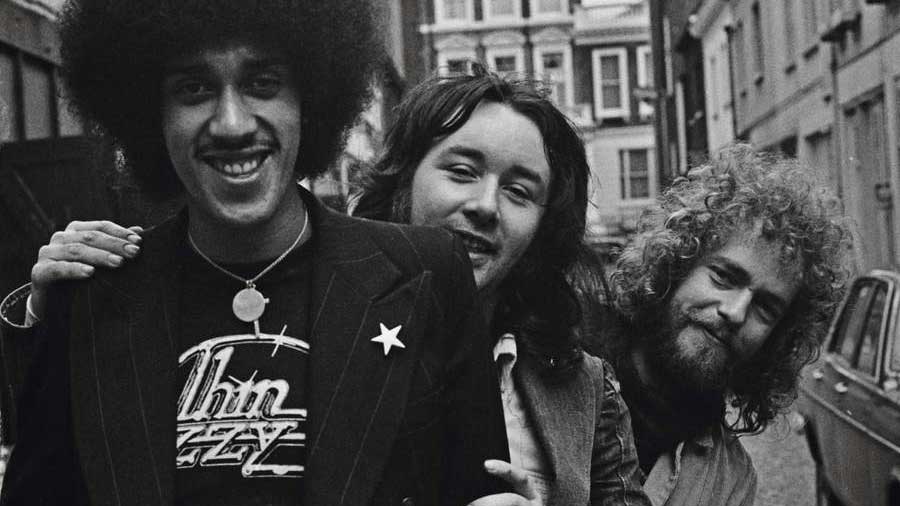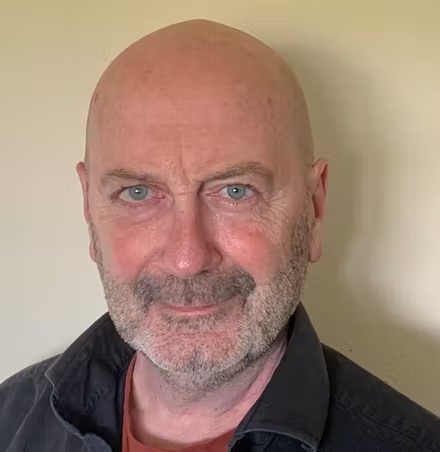Scott Gorham flashed that famous California-sun smile as he recalled his audition for Thin Lizzy in 1974. “The whole thing was wild and raucous, with the guitars out front,” he said. “Phil asked me to join that night, and gave me their records, because I’d never heard anything they had done. And here’s their one hit single, Whiskey In The Jar. I take it home, and I’m expecting to hear what I heard at rehearsal, right? Except what I’m hearing is ‘da-der-derblederble-derble…’ I’m going: ‘What the fuck is this?’. Took an instant dislike to it.
“So after about six months of playing this damn song, I go to Phil and say: ‘You know, Whiskey In The Jar, it’s great, but we got a new band now, you know?’ He goes: ‘Yeah, I get it. Let’s get rid of Whiskey In The Jar.’ Like it was that easy. Now if I reverse the whole thing, and say a new guy comes in years later and goes: ‘You know, Scott, this is a whole new thing. I think we’ve got to drop The Boys Are Back In Town. Heaven to God! I’d be: ‘You’re so fucking fired!’”
But then, as Lizzy leader Phil Lynott once told me: “I hated it that for years that was the only song we were known for. It was like a novelty song. Like Yellow Submarine. Would the fuckin’ Beatles have played that?” Well, no. But then The Beatles already had a zillion No.1 hits when they threw Ringo a bun and let him sing Yellow Submarine.

In the summer of ’72, Thin Lizzy were nobodies, in desperate need of a hit. Their first two albums had been commercial disasters, and their label, Decca, was about to drop them.
“We used to say: ‘When are we going to waste another few weeks making an album that won’t sell?’” recalls drummer Brian Downey. When their manager Ted Carroll talked Decca into giving the band one last chance with a single, Lynott felt sure he had the answer in a powerful, Hendrix-influenced funk-rock groover he’d written called Black Boys On The Corner.
“Phil had written this great song especially for the single, which he saw as part Hendrix, part commercial pop tune,” Downey remembers. “I think it was the first song he’d written about being black, and it was important to him.”
All they needed was a B-side. But with Lynott determined not to use another of his own songs, preferring to keep the good stuff for the next album, the band worked up an electric version of an old traditional Irish ballad called Whiskey In The Jar that Lynott and original Lizzy guitarist Eric Bell had strummed in smoky Dublin folk clubs for Guinness-and-hash money.
As Bell recalled in 1973: “We were rehearsing in the Duke Of York pub in King’s Cross in London, and Phil picked up the Telecaster and just began singing Whiskey to his own accompaniment, and I found that little riff which announces the song and runs through it now on the disc. Ted Carroll heard us fooling around on it and started enthusing about how good it sounded. So we put it together a little more solidly.”
“It was an afterthought,” says Carroll. “But Eric worked up this fantastic electric guitar version, with that brilliant intro of his, and the first time I heard it I said: ‘This is a hit!’” Decca head honcho Dick Rowe agreed, and unilaterally switched the tracks around, making Whiskey the A-side and Black Boys the B-side. It was left to Carroll to tell the band. And they were not pleased.
“Phil was furious,” says Carroll. “He’d put so much into Black Boys, seeing it as the band’s first big statement single. But we were in no position to argue. Lizzy were really in debt at the time and things were getting desperate. Decca wanted Whiskey as the A-side, so we went with it, and the band began playing it live.”
So desperate were the band, in fact, that they had just accepted £1,000 (around ten grand in today’s money) to record an album of Deep Purple covers, under the fictional aegis Funky Junction. “Phil saw himself as more of a Rod Stewart than an Ian Gillan,” says Downey, “so he did the bass and some backing vocals, and Ted got in Benny White, the singer from another Irish band he managed called Elmer Fudd, who was like a copycat Gillan.”
With Jon Lord-style keyboards by Fudd’s Dave ‘Mojo’ Lennox, and a photo of another band completely on the cover (Hard Stuff, also managed by Carroll), the album Funky Junction Play A Tribute To Deep Purple went on sale in Woolworth in January 1973, priced just 50p. “It was an embarrassment,” says a cringing Downey. “But we were desperate for the cash. It got us out of a jam so we could carry on going as Thin Lizzy
After that album, a rocked-up version of Whiskey In The Jar represented a massive step forward – at least in terms of profile in Ireland where it reached No.1. But despite Decca chopping the track down from five minutes-plus to three-and-a-half by editing out most of Bell’s dappled, Gaelic-lilt guitar solo, it looked like its chances of breaking the band in the UK were slight.
“John Peel liked the band and would play us on his show,” Lynott recalled. “And a few other ‘specialist DJs’, as they called them, like Kid Jensen and Stuart Henry, loved us, but you would never hear us on the radio in the day.”
Until, that is, Carroll had another brainwave. “I decided to send these miniature bottles of Whiskey to some of the producers at Radio 1 [and Top Of The Pops and the The Old Grey Whistle Test]. I peeled off the labels and replaced them with some we’d had made up with ‘Whiskey In The Jar: Thin Lizzy’ on them. It worked a treat, and Radio 1 finally began playing the song.”
By March it was nestled at No.6 in the UK chart and Lizzy were making their debut appearance on Top Of The Pops. But it was a joke version, Bell says now, not to be taken seriously. “When it became a hit I couldn’t believe it, having to go on telly playing it, or miming to it, which I hated.” Further infuriating the band was Decca’s thoughtless misspelling of ‘Whiskey’ – the Irish spelling – on the record sleeve as ‘Whisky’, the English spelling of the golden grain. Heresy.
“Whiskey In The Jar was a huge embarrassment to all of them,” Lynott’s then live-in girlfriend Gale Clayden told me. “They were supposed to be a rock band! But Phil was driven. He was going to do whatever it took to make it happen.”
“Eric had a problem with it,” says Carroll. “None of them really liked it. But Whiskey was a huge hit. The biggest Lizzy ever made, selling more copies even than The Boys Are Back In Town [released later, in ’76]. It was a turning point for the band. They went from playing clubs to fifty people a night to headlining halls to a thousand people a night.”

Although he was loath to admit it at the time, fearing, as he said, that people would think of Lizzy as “this electric Irish folk band”, the fact is that Lynott felt a real connection to the song. On the one hand, as Downey recalls: “Phil was such a tough cookie, a hard man. You didn’t mess.”
But there was another side too. Lynott was shy, gently spoken, devoured Irish history books. He loved the plaintive folk ballads of the mythological Celtic past, and would reference 19th-century Dublin poets such as Clarence Mangan, who had influenced James Joyce.
“To hear Phil speak, Ireland was the greatest place in the world,” Scott Gorham says. “He’d drag me along to some well and go: ‘You know what happened here?’ I’d be: ‘You know what? I don’t really give a fuck.’ He’d be like: ‘Well, I’m gonna tell ya anyway! Here in the twelfth century…’ He knew all the dates and names and which battles happened.”
The origins of the song – about a stand-and-deliver Irish highwayman who robs a governor-laird – are caked in layers of unreliable oral histories, but likely go back to the 17th century, sharing some of its lines and plot with the broadside ballad Patrick Fleming, named after the notorious Irish highwayman executed in 1650.
Over the centuries there were dozens of versions of the song, with various locations mentioned including Kerry, Kilmoganny and Sligo Town. Thin Lizzy placed the tale of the highwayman betrayed by his woman in ‘the Cork and Kerry mountains’. The names in the song also change. The Captain Farrell of Lizzy’s version becomes a Colonel called Pepper and many other nom de plumes; the ‘Molly’ that Lynott sings of is also variously known as Jenny, Emzy, Ginny – or indeed any name that fits the stanza.
Another notable rendering of the song turned up in 1728 in the English poet and dramatist John Gay’s The Beggars Opera, said to be inspired by Gay hearing an Irish ballad-monger belting it out in a Soho tavern.
According to the American music historian Alan Lomax, “the folk of seventeenth-century Britain liked and admired their local highwaymen; and in Ireland (or Scotland) where the gentlemen of the roads robbed English landlords, they were regarded as national patriots. Such feelings inspired this rollicking ballad”.
But for all the success and attention that Whiskey In The Jar brought Thin Lizzy, when their next album, Vagabonds Of The Western World, was another flop, and the band were finally dropped by Decca, Lynott’s fear that they would be one-hit wonders seemed to be confirmed.
As we now know, it was the dark before the dawn, and a new, upgraded ‘live and dangerous’ Thin Lizzy would become the one the world now recalls most fondly. Eric Bell, who left Lizzy not long after Whiskey, recalls watching the band on Top Of The Pops in their Boys Are Back pomp: “I thought: ‘Fuck me, Philip!’ He was dressed in black leather with a black studded armband on, portraying a hard man. I thought: ‘Ah, right, that’s his new image. He’s reinvented himself. He doesn’t want to play Whiskey In The Jar any more.’"

Whiskey In The Jar through the years
As well as the myriad versions of Whiskey In The Jar down the centuries, there have been several popular interpretations of the song since Thin Lizzy had their biggest hit single with it in 1973.
In 1990, Irish folk band The Dubliners (it was their rascally 1967 version of Whiskey that Lynott first fell in love with) re-recorded the song with The Pogues, in a ferocious, almost certainly drunken collision of traditional Irish-folk-meets-revved-up-rebel-punk, with ‘the far-famed Kerry mountains’ replacing Lynott’s ‘Cork and Kerry mountains’, and ‘Jenny’ instead of ‘Molly’.
When Metallica tackled Whiskey in 1998, it was Thin Lizzy they were paying tribute to more than the song, with words and chiming Eric Bell guitar intact, albeit muddied by metal. It won them a Grammy. Bryan Adams also stuck to the Lizzy template for his 2019 version, albeit returning the song to its acoustic roots.
There is also an acoustic version by the Grateful Dead from 1993 that keeps the chorus but brings its own lyric: ‘We’ll fight for Uncle Sam,’ referencing the Irish presence in the American Civil War.

